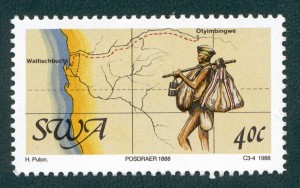Namibia is purported to have some of the most beautiful postage stamps in the world. But what’s more fascinating, are the stories behind the artful images they depict—plant and animal life, traditional cultures, history, and landmark events.
Postal Runners
 In today’s world of instant communication, it’s hard to envision the mail system that existed in 1840 when Africa was dubbed the Dark Continent. Not only was mail delivery slow, with letters taking up to two years to reach their destination, it was dangerous!
In today’s world of instant communication, it’s hard to envision the mail system that existed in 1840 when Africa was dubbed the Dark Continent. Not only was mail delivery slow, with letters taking up to two years to reach their destination, it was dangerous!
History
A postal runner service was established in 1814 to deliver messages between missionary posts, expanding to the seas where ships would deliver the precious cargo back and forth to families at home. Delivery was sporadic for several reasons, but it was the land delivery that was most dangerous.
“They [runners] covered hundreds of kilmetres on foot, in the murderous heat of summer and bitter cold of winter. They were able to carry up to 17kg. of mail. The mailbag was tied to a stick that they carried on one shoulder and a bag carrying their provisions was attached to the other end of the stick. They were faster and more reliable on foot than saddle oxen or oxcarts.”[1]

Postal fees needed to cover the runner, his wages, and his provisions—all paid in British pounds, and in kind. You can imagine that it got quite pricey and required prepayment.
The postage stamp was developed in Britain to demonstrate proof that the sender had paid the delivery costs. Although the method of prepayment referred to as a stamp was developed in 1680, the physical printed paper with adhesive back came about in 1840.
The need for runners disappeared when the railway was built in the early 1900’s, and mail that taken two years to arrive, now was delivered in an unheard of six or seven weeks.
Source: Stamps and Stories, Vol. 1, 50 Stories on Namibia’s Postal Stamps, Gondwana Collection Namibia, & NamPost, 2012
Photo credit: Ted Lawson
[1] Stamps and Stories, p. 11

